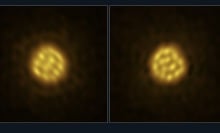Unlike giant stars that explode into a supernova and collapse into a black hole, a medium star like Earth's sun just keeps on trucking until it runs out of nuclear fuel, suffering a more prolonged death.
As a sun-like star nears the end of its life, it expands into a red giant, about 100 to 1,000 times its original size, eventually overtaking the space around it, including nearby planets.
For decades, astronomers have seen the "before" and "after" of this process — when a planet is orbiting very close to its star and the bloated stellar old-timer has engulfed the planet. Just last year, an MIT-led research team caught a dying star in the act of absorbing a planet.
Many astronomers think this is the fate of Earth in about 5 billion years: The sun will puff up and eventually consume Earth, along with Mercury and Venus. But a new observation with the W. M. Keck Observatory's 10-meter telescope in Hawaii is challenging that prediction with another potential outcome. About 4,000 light-years away in the Milky Way, scientists have seen a rocky world continuing to orbit a white dwarf, the remaining dim core of the once-active star.
"Whether life can survive on Earth through that (red giant) period is unknown. But certainly the most important thing is that Earth isn't swallowed by the sun when it becomes a red giant," said Jessica Lu, chair of astronomy at the University of California at Berkeley, in a statement. "This system … is an example of a planet — probably an Earth-like planet originally on a similar orbit to Earth — that survived its host star's red giant phase."

The research, led by astronomer Keming Zhang while a doctoral student at Berkeley, will be published in the journal Nature Astronomy. The discovered exoplanet's system is composed of a white dwarf about half the mass of the sun, a so-called "brown dwarf" sometimes described as a failed star, and an Earth-size world. Viewing the extremely distant system was made possible through microlensing, a natural phenomenon that extends a telescope's range by acting as a colossal magnifying glass in the sky.
The paper suggests that as a medium star inflates into a red giant, its diminishing mass could push its planets out to farther orbits. If this scenario happened in our solar system, this could offer a sliver of a chance for Earth to survive longer.
By the end of the red giant phase, the sun is expected to have withered to a white dwarf no bigger than Earth with about half its mass intact. By that point, Earth would be in an orbit twice its current size.

Two years ago when the James Webb Space Telescope was commissioned, NASA revealed a highly detailed glamor shot of the Southern Ring Nebula, a gas cloud surrounding a white dwarf that sloughed off its outer layers. The sun, estimated to be at the midpoint of its own life, is halfway there, Klaus Pontoppidan, an astronomer at the Space Telescope Science Institute in Baltimore, explained at the time.
Of course, Zhang points out, life on Earth will face mortality much sooner than when the planet comes face-to-face with the sun in its red giant era. A runaway greenhouse effect is expected to vaporize all of Earth's oceans in just a billion years.
But here's another thin shred of hope: As the red giant version of the sun grows, the habitable zone may move as far out into the solar system as Jupiter and Saturn. Perhaps some of these gas giants' moons — Europa, Callisto, Ganymede, and Enceladus — could turn into hospitable water worlds as their icy shells melt.
"I think, in that case, humanity could migrate out there," Zhang said.















